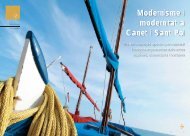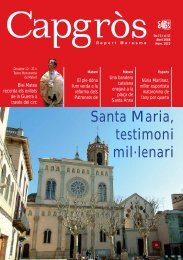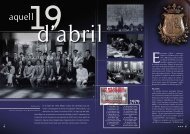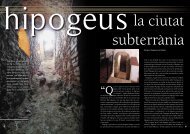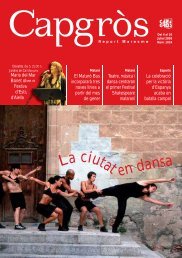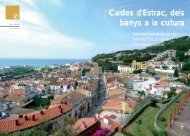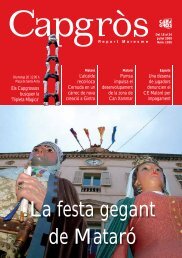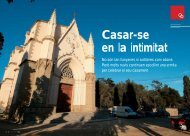L'herència modernista - CapGros.com
L'herència modernista - CapGros.com
L'herència modernista - CapGros.com
You also want an ePaper? Increase the reach of your titles
YUMPU automatically turns print PDFs into web optimized ePapers that Google loves.
Re<br />
Capgròs<br />
també en<br />
anglès<br />
Report Maresme<br />
The cradle of Catalan modernism<br />
Canet de Mar was home to the modernist<br />
movement in Catalonia. One of its pioneers,<br />
Lluís Domènech i Montaner, projected the<br />
whole of his work from this Maresme village,<br />
the most outstanding examples of which are<br />
the Hospital de Sant Pau and the Palau de la<br />
Música of Barcelona. This modernist presence<br />
in the building of the town was thanks to trade<br />
with America. Those who had made their fortune<br />
by exchanging products between one continent<br />
and another, would <strong>com</strong>e to the village and have<br />
large houses built as evidence of their wealth<br />
and prosperity. This coincided with the birth of a<br />
new type of architecture, Modernism, in Catalonia<br />
which led to the arrival of such architecture in the<br />
town. In Canet de Mar there are great modernist<br />
buildings designed by Domènech i Montaner<br />
and his son Pere, as well as other great artists<br />
of the time like Mataró’s Josep Puig i Cadafalch<br />
and Emili Cabañes. In constructions such as the<br />
Casa Roura, Canet’s centre of culture or the<br />
town hall one can see <strong>com</strong>pletely modernist<br />
work, neoclassical, ecclesiastic, colonial and<br />
neo-gothic pieces with different touches which<br />
are emblematic of the movement which began to<br />
prevail at the beginning of the 20th Century.<br />
With this heritage, Canet de Mar Council has<br />
decided to set up the fi rst modernist market on<br />
13th and 14th September. This will retrace the<br />
architectural heritage, the gastronomy (several<br />
restaurants will prepare dishes typical of the<br />
end of the 19th Century during the fair), artisan<br />
trades and the customs which reigned 100 years<br />
ago. The fair will boast a market with 60 stalls,<br />
workshops, streets decorated in accordance<br />
with the time, activities for youngsters and a<br />
drawing and painting fair among other attractions.<br />
Guided tours are a particularly special event, and<br />
some of these can indeed be done in groups<br />
all year round.<br />
Among these tours we have a trip around the<br />
historic centre, which visits the buildings which are<br />
most representative of modernism and of Canet<br />
de Mar’s recent history, such as the centre of<br />
culture, the Casa Roura, the Casa Josep Floris,<br />
the church, the Steps of Sant Crist and the town<br />
hall, among others. The newest addition is the<br />
train-ride and the visit to Santa Florentina Castle,<br />
a medieval fortress which Domènech i Montaner<br />
<strong>com</strong>pletely refurbished. In this building, which is<br />
emblematic here in Canet, there is a crypt where<br />
Florentina Malató, his uncle’s wife, was buried<br />
and which has never been open to the public<br />
until now. The visit to the Casa Museu Lluís<br />
Domènech i Montaner includes an exhibition of<br />
different pieces and documents which review the<br />
life and work of the Catalan architect, who also<br />
made his mark in politics due to his involvement<br />
with Catalonia’s roots.<br />
14 núm.1030 núm.1031 15



